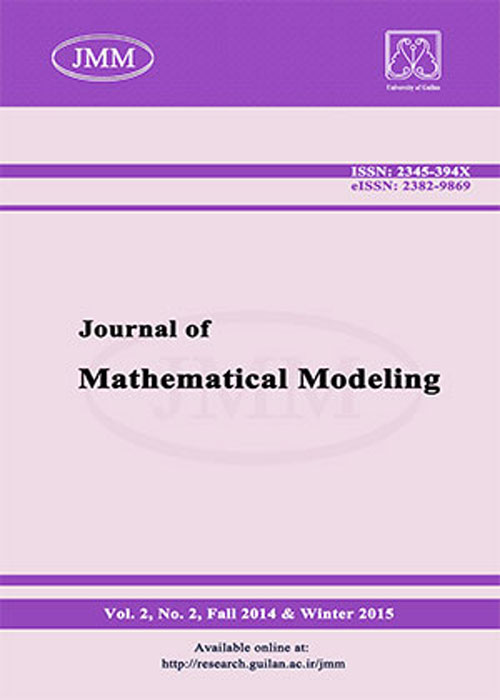فهرست مطالب

Journal of Mathematical Modeling
Volume:8 Issue: 2, Spring 2020
- تاریخ انتشار: 1399/02/12
- تعداد عناوین: 6
-
Pages 105-122In this work, we develop a new $SEID$ (Susceptible-Exposed-Infected-Deny) racism propagation model, which describes the racism diffusion. The racism-free and prevalence equilibrium points are calculated and its stability is analyzed. The threshold value of the model $R_0$ is derived. As a result of theoretical analysis, racism spread is under control when $R_0leq 1$. While, if $R_0>1$ the racism propagates in the cyberspace. Furthermore, the sensitivity analysis of the parametric values of the model are illustrated. We use textsc{Matlab} ode45 solver to illustrate the numerical solutions. Finally, from theoretical analysis and numerical solutions, we obtain mutually consistent results.Keywords: Cyberspace, racism spread, compartment model, Stability analysis, numerical results
-
Pages 123-138An amperometric biosensor in trigger mode is a type of biosensor which is used to improve the sensitivity and specificity of the detection event by coupling different enzymes. In this paper, we study a numerical scheme to solve the one-dimensional diffusion-reaction equations with a nonlinear term related to Michaelis-Menten kinetics of the enzymatic reactions. In order to simulate numerically the model under study, we discretize the time variable with a semi-implicit backward Euler approach. Also, we use the meshfree collocation method based on thin plate spline radial basis function for the discretization of the spatial derivative. The biosensor response with and without amplification has been compared. The influence of the normalized Michaelis constant, the maximal enzymatic rate and substrate concentration on the triggering biosensor response is investigated.Keywords: Biosensor, trigger mode, Michaelis-Menten kinetics, thin plate spline radial basis function
-
Pages 139-155In this paper, we use Chebyshev polynomials to seek the numerical solution of a class of multi-variable order fractional differential equation (MVODEs) that the fractional derivative is described in the Caputo-Prabhakar sense. Using operational matrices, the original equations are transferred to a system of algebraic equations. By solving the system of equations, the numerical solutions are acquired that this system may be solved numerically using an iterative algorithm. The effectiveness and convergence analysis of the numerical scheme is illustrated through four numerical examples.Keywords: Prabhakar function, multi-variable order, fractional derivative, the fifth-kind Chebyshev polynomials, numerical method
-
Pages 157-176In this paper, a new two-parameter estimator is proposed. This estimator is a generalization of two-parameter (TP) estimator introduced by Ozakle and Kaciranlar (The restricted and unrestricted two-parameter estimator, Commun. Statist. Theor. Meth. 36 (2007) 2707--2725) and includes the ordinary least squares (OLS), the ridge and the generalized Liu estimators, as special cases. Here, the performance of this new estimator over the TP estimator is theoretically investigated in terms of quadratic bias (QB) criterion and its performance over the OLS and TP estimators is also studied in terms of mean squared error matrix (MSEM) criterion. Furthermore, the estimation of the biasing parameters is obtained, a numerical example is given and a simulation study is done as well.Keywords: Generalized Liu estimator, Lagrange method, mean squared error, ridge estimator, two-parameter estimator
-
Pages 177-188An implicit finite difference method is implied to approximate a parabolic partial differential equation for capillary formation in tumor angiogenesis. After that, the stability analysis of the method will be investigated. At the end, some numerical simulations are considered to show the applicability and efficiency of the scheme.Keywords: Parabolic partial differential equations, Tumor angiogenesis, Finite difference method, Stability analysis
-
Pages 189-206In the present paper, we propose a new method for solving large-scale generalized differential Sylvester equations, by projecting the initial problem onto the extended block Krylov subspace with an orthogonality Galerkin condition. This projection gives rise to a low-dimensional generalized differential Sylvester matrix equation. The low-dimensional equations is then solved by Rosenbrock or BDF method. We give some theoretical results and report some numerical experiments to show the effectiveness of the proposed method.Keywords: Extended block Krylov subspace, Generalized differential Sylvester matrix equation, low-rank approximate solution, Rosenbrock method, BDF method

